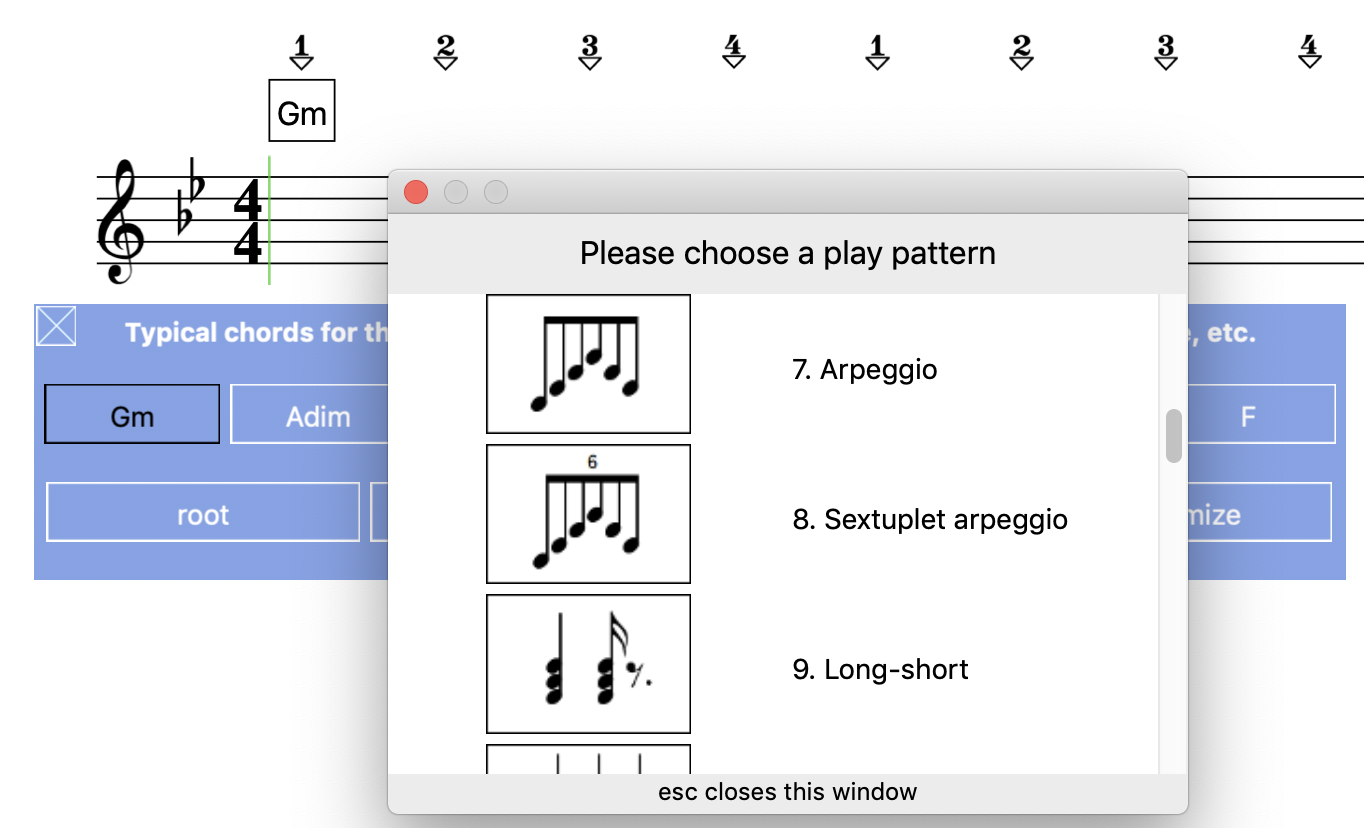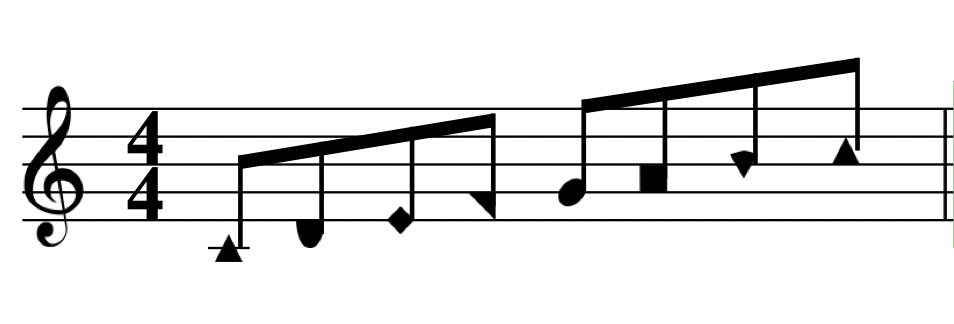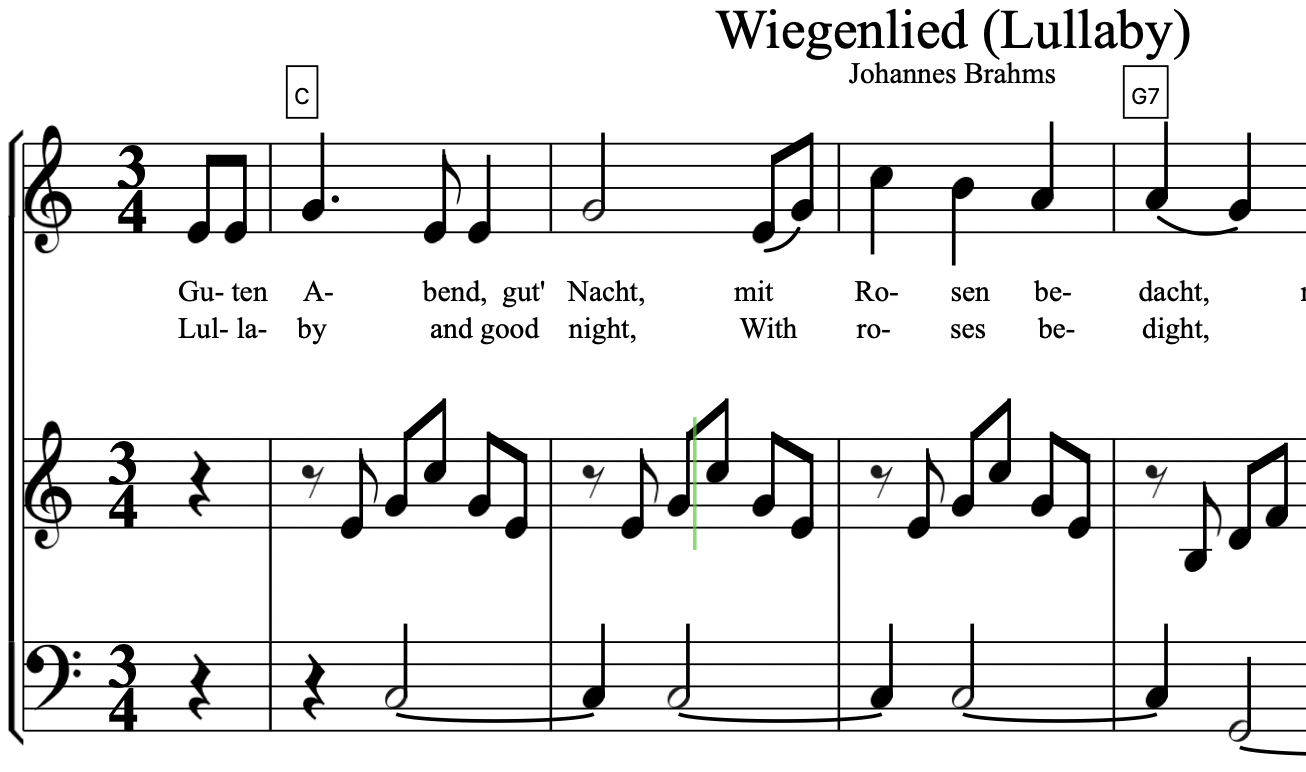|
(All music images are from the Songworks screen *)
Easy note entry (click a note where you want it to go, or choose a note tool and play it on the piano). You can choose to have the program enter bar lines automatically, or enter them yourself where you want them. Songworks does not require you to set up measures in advance.

Ideas! Songworks can invent tune ideas for fun and inspiration - it can invent them in any key, with or without chord accompaniment, can suggest chords for your own tune and tunes for your own chords. Or enter a rhythm - such as the rhythm of a lyric you have in mind - and Songworks can invent a tune using that rhythm. These are endlessly different and can be very interesting owing to our unique method of generating melody and harmony.

Transpose and transform Instantly transpose a piece to any key. Just tell Songworks how much you want the piece raised or lowered, and it will choose the appropriate key signature and take care of the whole business. You can also use composition tools such as tonal transposition of passages, tonal inversion, retrograde, etc. A staff can also be set to be a "transposing staff" for instruments such as Bb Clarinet that sound at a pitch different from the one you see.
Easy viewing. Songworks 3 had just 2 viewing sizes - small and large. Songworks 4 lets you zoom in or out as needed.
Edit in either page or panorama (left-right) view. Page view editing is good for large pieces, so that you're focused on one page at a time. And in page view you can separately arrange the staff systems for each page.
Easy entry of lyrics or other text. Lyric syllables align automatically with notes. You can write a whole verse of lyric, then drag it to a "lyric line" guide if you want it to follow notes of the staff. Lyrics pay attention to ties and slurs, too.

Easy entry of chord symbols. If you want to include chord symbols you can use the standard names supplied by Songworks, or edit the name as you prefer.
Chord symbols are audible!. You can choose between various accompaniement patterns for chord symbols. Hearing the chord symbols together with the melody is a big help when writing a "lead sheet" (melody with chords). It's also more fun if you are practicing by playing along with the computer's accompaniment.

Easily print at any size. Tiny notes or big notes. If the scaling is set small, more measures fit on the printed page. Print scaling is separate from the zoom feature, so zooming doesn't affect the layout.
Everything's adjustable! Drag note stems to adjust flags and beams, drag bar lines to compress or expand measures (Songworks does not require a fixed number of measures per line). Songworks will position items proportionally in each measure even when you shrink or expand a measure. Drag notes up or down to change their pitch, drag them left or right to fine-tune their positions, and drag control boxes to change the curve of a slur or the angle of a bracket.
Independent control of staff systems Songworks 4 lets you adjust the space between any staff systems in page view - allowing, for example, some extra space for a block of text.
Can automatically convert chord symbols to simple written piano accompaniment with your choice of accompaniment pattern.
Flexible input methods. Use the letter keys "piano" or an external MIDI instrument, or the mouse. The letter keys can act either as a normal (but short!) piano (the middle row, a,s,d,f.. serve as the white keys of a piano). The number keys can simultaneously be used to change the sounding chord, so this is an easy way to improvise melodies. If you like something you're doing, turn on the "record" feature and play it again so that Songworks can notate it for you (note: that does require a fast computer, so be sure to not have other tasks running in the background if you want to auto-notate a tune.)
Listen to any individual staff or combination of staves in a polyphonic composition.
This is particularly useful when combined with Active Listening,™ in which you tap the rhythm* of a chosen part, its pitches
come out automatically, and the other parts play along with you - a great way to learn your part in a chorale, and fun for its own sake.
Extract orchestra or vocal parts from a score.
Supports Shape Notes. (Both 4 and 7-shape systems - and chooses the right shapes for you). Also supports percussion note heads, stick notation, and stemless (liturgical) notation.

Imports and exports MusicXML files. MusicXML by Ricordare is a universal notation format. Unlike MIDI files, MusicXML contains full information about the appearance of a score. Songworks 4 can import and export "partwise" MusicXML files that contain the most important visual elements in a Songworks score. Songworks also imports and exports MIDI files, and imports ABCMusic too.
Windows and Mac versions are file-compatible. (You can use the same music files with either).
Instructional Videos. Visit our YouTube instructional videos to see the Songworks 4 interface and sample compositions.
Don't forget the Customer Testimonials...
Notes sound as they are entered or dragged on the staff. Or not, if you prefer. Dragging notes up or down is a quick way to change pitch.
Cue and Grace notes Notes and other symbols can be printed in smaller than usual size as "cue" notes or graces; graces are performed rather than being visual only (your choice of on-the-beat or before).
Demo Software: Download a Mac Demo or a Win Demo.
And more...
|











